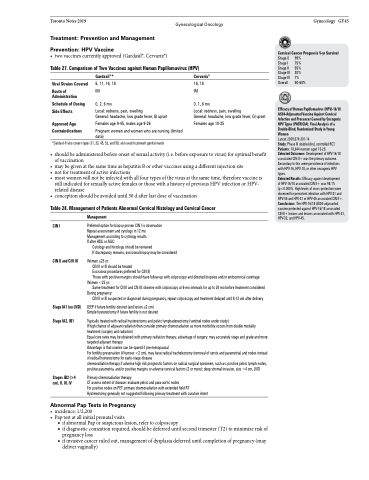Page 531 - TNFlipTest
P. 531
Toronto Notes 2019
Gynecological Oncology
Gynecology GY45
Treatment: Prevention and Management Prevention: HPV Vaccine
• twovaccinescurrentlyapproved(Gardasil®,Cervarix®)
Table 27. Comparison of Two Vaccines against Human Papillomavirus (HPV)
Cervical Cancer Prognosis 5-yr Survival
Stage 0 99% Stage I 75% Stage II 55% Stage III 30% Stage IV 7% Overall 50-60%
Efficacy of Human Papillomavirus (HPV)-16/18 AS04-Adjuvanted Vaccine Against Cervical Infection and Precancer Caused by Oncogenic HPV Types (PATRICIA): Final Analysis of a Double-Blind, Randomized Study in Young Women
Lancet 2009;374:301-14
Study: Phase III double-blind, controlled RCT. Patients: 18,644 women aged 15-25.
Selected Outcomes: Development of HPV-16/18 associated CIN II+ was the primary outcome. Secondary to this were persistence of infections with HPV-16, HPV-18, or other oncogenic HPV types.
Selected Results: Efficacy against development
of HPV-16/18 associated CIN II+ was 98.1% (p<0.0001). High levels of cross-protection were observed for persistent infection with HPV-31 and HPV-45 and HPV-31 or HPV-45 associated CIN II+. Conclusions: The HPV-16/18 AS04-adjuvanted vaccine protected against HPV-16/18 associated CIN II+ lesions and lesions associated with HPV-31, HPV-33, and HPV-45.
Viral Strains Covered
Route of Administration
Schedule of Dosing Side Effects
Approved Age Contraindications
Gardasil®*
6, 11, 16, 18 IM
0, 2, 6 mo
Local: redness, pain, swelling
General: headache, low grade fever, GI upset
Females age 9-45, males age 9-26
Pregnant women and women who are nursing (limited data)
Cervarix®
16, 18 IM
0, 1, 6 mo
Local: redness, pain, swelling
General: headache, low grade fever, GI upset
Females age 10-25
*Gardasil-9 also covers types 31, 33, 45, 52, and 58; also used to prevent genital wards
• should be administered before onset of sexual activity (i.e. before exposure to virus) for optimal benefit of vaccination
• maybegivenatthesametimeashepatitisBorothervaccinesusingadifferentinjectionsite
• notfortreatmentofactiveinfections
• most women will not be infected with all four types of the virus at the same time, therefore vaccine is
still indicated for sexually active females or those with a history of previous HPV infection or HPV-
related disease
• conceptionshouldbeavoideduntil30dafterlastdoseofvaccination
Table 28. Management of Patients Abnormal Cervical Histology and Cervical Cancer
CINI
CIN II and CIN III
Stage IA1 (no LVSI) Stage IA2, IB1
Stages IB2 (>4 cm), II, III, IV
Management
Preferred option for biopsy-proven CIN I is observation Repeat assessment and cytology in 12 mo Management according to cytology results
If after HSIL or AGC:
Cytology and histology should be reviewed
If discrepancy remains, excisional biopsy may be considered
Women ≥25 yr:
CIN II or III should be treated
Excisional procedures preferred for CIN III
Those with positive margins should have follow-up with colposcopy and directed biopsies and/or endocervical curettage
Women <25 yr:
Same treatment for CN II and CN III: observe with colposcopy at 6-mo intervals for up to 24 mo before treatment considered
During pregnancy:
CIN II or III suspected or diagnosed during pregnancy, repeat colposcopy and treatment delayed until 8-12 wk after delivery
LEEP if future fertility desired (and lesion ≤2 cm) Simple hysterectomy if future fertility is not desired
Typically treated with radical hysterectomy and pelvic lymphadenectomy (sentinel nodes under study)
If high chance of adjuvant radiation then consider primary chemoradiation as more morbidity occurs from double modality treatment (surgery and radiation)
Equal cure rates may be obtained with primary radiation therapy; advantage of surgery: may accurately stage and grade and more targeted adjuvant therapy
Advantage is that ovaries can be spared if pre-menopausal
For fertility preservation (if tumour <2 cm), may have radical trachelectomy (removal of cervix and parametria) and nodes instead of radical hysterectomy for early-stage disease
chemoradiation therapy if adverse high risk prognostic factors on radical surgical specimen, such as: positive pelvic lymph nodes, positive parametria, and/or positive margins or adverse cervical factors (2 or more): deep stromal invasion, size >4 cm, LVSI
Primary chemoradiation therapy
CT assess extent of disease: evaluate pelvic and para-aortic nodes
For positive nodes on PET: primary chemoradiation with extended field RT Hysterectomy generally not suggested following primary treatment with curative intent
Abnormal Pap Tests in Pregnancy
• incidence: 1/2,200
• Paptestatallinitialprenatalvisits
■ if abnormal Pap or suspicious lesion, refer to colposcopy
■ if diagnostic conization required, should be deferred until second trimester (T2) to minimize risk of
pregnancy loss
■ if invasive cancer ruled out, management of dysplasia deferred until completion of pregnancy (may
deliver vaginally)


